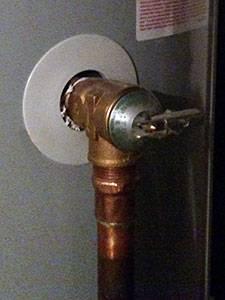Can You Take The Pressure?
 Protect your family and your home.
Protect your family and your home.
A temperature and pressure relieve valve is a required component on all water heating systems. What makes this safety device so important is the severity of water heater explosions. We are not just talking about your utility room taking a good soaking as water escapes from the storage tank. Your water heater can actually explode like a bomb or launch itself through the roof of your house. Imagine the possible damage and injury this could cause.
Did you know an old pressure relief valve can fail?
There are two situations that should cause your temperature and pressure relief valve to open.
- Water pressure exceeds 150 psi.
- Water temperature in the tank exceeds 210 degrees Fahrenheit.
However with age, your temperature and pressure relief valve can fail. You should test the valve at least once a year and replace the valve when necessary.
Test the temperature and pressure relief valve annually.
To test that the relief valve functions you should do the following at least once per year.
- Place a bucket under the discharge pipe for the temperature and pressure relief valve.
- Open the valve and let the water flow for 5 seconds.
- Close the valve and verify that the valve has completely sealed. There should be no dripping from the valve after it has closed.
If the valve fails to open or seal itself after running for at least 5 seconds replace the valve immediately.
You may also want to verify that your home's water pressure is safe and that the water heater temperature is properly set.
- Testing water pressure: Use a pressure tester designed to screw onto the end of a faucet that has threads. Ideal water pressure is between 50 & 60 psi. Anything that registers under 80 psi is considered safe.
- Verify temperature setting: Examine the temperature setting gage on your water heater to verify that it is set to a safe temperature. The standard temperature setting is considered to be 120 degrees Fahrenheit.
Call AEM Mechanical Services, Inc., at 320-587-0991 for help testing your pressure and temperature relief valve or testing the water pressure in your home.
About the author
2008 - 2020 © AEM Mechanical Services, Inc. - all rights reserved
MN License #34376PM
Privacy Policy | Sitemap
Website created by Mid Minnesota Marketing

 Protect your family and your home.
Protect your family and your home.